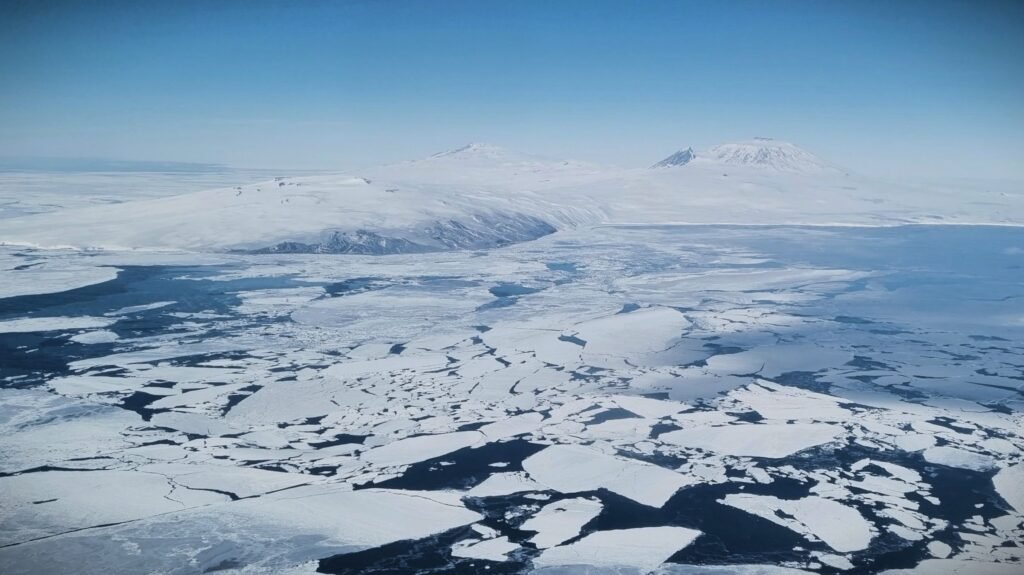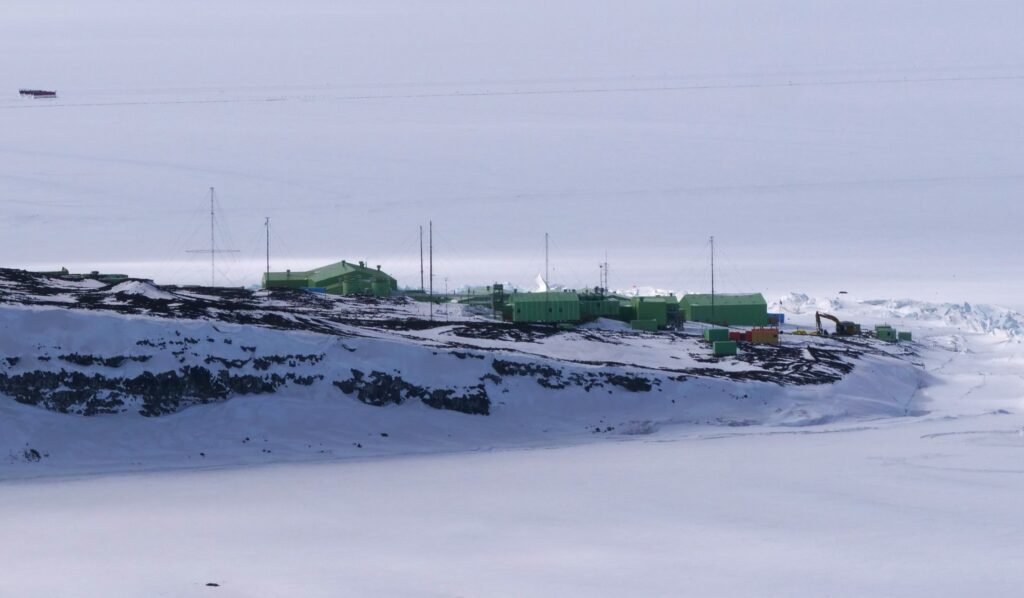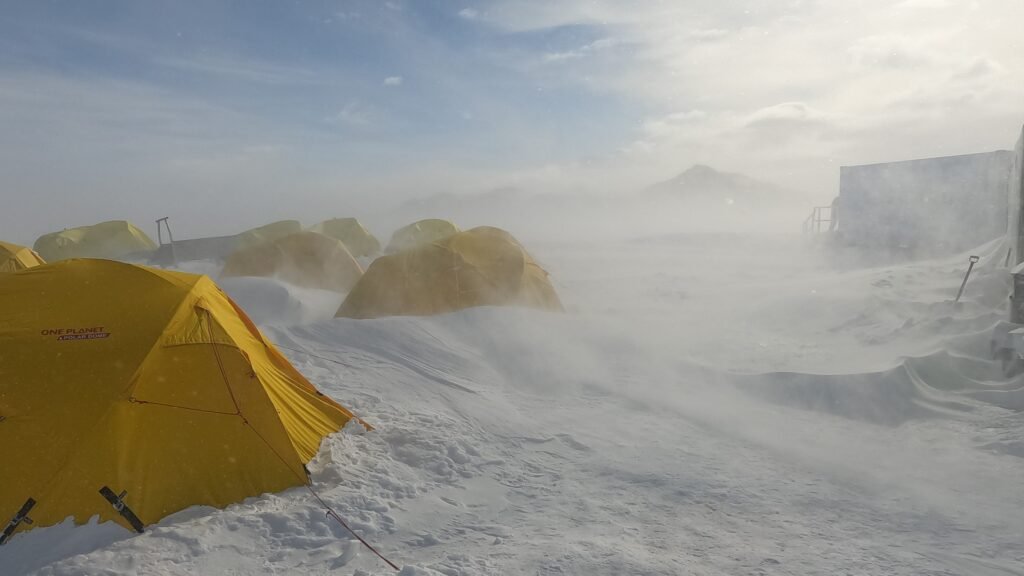10 Highlights from a trip to Antarctica
By Julian Thomson
Recently I returned from about 6 weeks in Antarctica, assisting a science team researching the microbes that live within the sea ice. We were based near Scott Base, and I was privileged to have time to learn about the science and explore some of the local landforms around McMurdo.
Here are 10 highlights from the experience:
1. The Flight
Apart from the impressive experience of flying on a huge C17 military plane, the views looking down to the unfolding icy wilderness of Antarctica are mesmerizing. Mountain ranges, glaciers, frozen ocean and eventually Ross Island as we closed in on the McMurdo Ice Shelf, our landing field. The landscape is totally devoid of human structures, roads or houses – a truly empty wilderness

2. Scott Base
Scott Base is a staging point for many New Zealand science expeditons that fly or drive out to their field sites on Ross Island, the Ice Shelf or the Transantarctic Mountains. Scott Base is an experience all of its own – You are looked after by a dedicated and high functioning group of specialists who look after the infrastructure, the machinery, the food, the domestic services, the field equipment and your safety whilst down on the ice. Whilst at the base you can venture out for various walks, go mountain biking and cross country skiing, or visit the much larger US McMurdo Station about 3kms away.

3. The Team
Science expeditions to Antarctica are limited due to the cost and logistics of travelling there and undertaking field work in such a remote and difficult environment. Science teams are usual small groups of a handful of people with different skill-sets. You are bunched together in a close knit group for weeks at a time and get to know each other’s strengths and weaknesses quickly and intensely. There is a strong sense of shared privilege and awe at being able to participate in such a life changing experience.

4. The Camp
The personal gear and camp equipment is super rugged as you would expect, as it has to keep you warm in extreme low temperatures and high winds. Apart from being tough for wear and tear, the principle of layering is key – you add or take away layers to adjust to the fluctuations of temperature through the day. Because the equipment is so good you can easily overheat when at work, but similarly you can get cold really quickly, for example if you take your gloves off to do a fiddly task or if some of your face is exposed when travelling on a skidoo. All the clothing you need is supplied for you and fitted before you leave New Zealand, whilst all camp gear is distributed out of the field equipment store at Scott Base.

5. The Science Research:
Our research project was led by Andrew Martin of Victoria University of Wellington, Te Herenga Waka. We were investigating rhodopsin proteins that form part of the cell membranes in sea ice bacteria. They have the ability to use energy from sunlight in a way that is quite new to science. This video gives an idea of some of the fieldwork we undertook:
6. Sea Ice
Up to 18 million square kilometres of the ocean around Antarctica freezes and then melts every year. This sea ice develops to about 1 or 2m thick. It is actually quite variable and not all of it melts so that some of it is multi-year ice.
The process of sea ice formation goes through several stages, which gradually dampen down the waves until a flat uniform sheet of sea ice can develop:
- Frazil ice is the initial stage in which tiny, small, flat, plate-like ice crystals form in the water. This typically happens when the ocean temperature drops below freezing point, and can occur in a matter of minutes to hours.
- Grease ice is the next stage, where the frazil ice crystals aggregate to form a soupy mixture of ice and water.
- Pancake ice is the stage where the grease ice has formed into circular disks with raised rims, called pancakes. These pancakes can range in size from a few centimeters to several meters, and typically form within days to weeks. As they develop they have the effect of flattening out the waves which stablises the sea surface and allows them to start stick together.
- Stable sea ice is the final stage of sea ice formation, and occurs when the pancakes have grown and fused together. Once this happens the ice quickly thickens and becomes a smooth sheet of sea ice, growing by addition of snow on the top and freezing of sea water below.
The weather conditions, such as air and ocean temperature, wind and ocean currents, all affect the rate of ice formation. Another thing to note is that as sea water freezes it squeezes out the salt which becomes concentrated brine at the base of the sea ice as well as in channels trapped within it.
This video will give you some idea about sea ice and also the underlayer of platelet ice that can develop:
7. Wildlife
There is not much wildlife at all in the depths of Antarctica, but in the coastal regions such as McMurdo Sound there are seals, penguins, skuas (a type of scavenging sea bird) that survive on the marine food chain starting with the microbial life in the sea ice and water. Around Scott Base the Weddel seals are the most obvious large animals and they are easily seen and photographed just outside the base. Penguin colonies occur a bit of a distance away and occasional travelling penguins turn up near to the base too.

8. The Geology
Scott Base is on Ross Island which is part of the complex of volcanic peaks around Mount Erebus. It is separated from the mainland of Antarctica and the Transantarctic Mountains by McMurdo Sound. Here is a short video about the geology immediately around Scott Base which is built on a lava flow that erupted from nearby Crater Hill:
9. The History
The Discovery Hut beside McMurdo Station was the starting point for Scott’s first attempt on the South Pole in 1902-3. There are two more huts from that heroic era of exploration at Cape Evans and Cape Royds. So the area is steeped in epic Antarctic history and these huts are some of the most atmospheric places imaginable. They still contain clothing, food and equipment from when they were last lived in including seal blubber and biscuits well over 100 years old. It makes a huge difference to have read the stories of Scott and Shackleton’s epic journeys before visiting the huts to get a feel for the significance of particular objects left behind.
I had the good fortune to be guided through the Discovery Hut by Lizzie Meek who works for the Antarctic Heritage Trust and spends a lot of time in Antarctica helping to conserve the many artifacts in the huts.


10. The Spell-binding Views.
One of the deepest impressions I am left with after my (3rd) visit to Antarctica is the incredible views across vast spaces to far distant mountains. The light is ever-changing as the sun rotates around the sky for 24 hours a day. The sense of space, light and emptiness keeps pulling your eyes up from the details of a task to the distant horizon. This video clip shows the 360 degree view from the top of Observation Hill near Scott Base:
So there you have it – 10 highlights from a trip to Antarctica in 2022.
Have you been there? Are you planning to go one day?
What are the experiences you are most interested in for a time spent down on the ice?
With many thanks to Antarctica New Zealand, the amazing people at Scott Base and the KO43 project team.
PS: After writing this post, I got inspired to create a video version – have a look and see what you think:


Thank you very much Julian, what an amazing adventure…and now I know what a “spindle bomb” is and looks like.
Thanks Sam! Glad you enjoyed the post!
Thanks!
Thank you so much for sharing these videos! Although I have seen pictures of these areas, the video just makes everything come alive.
I will be traveling to Antarctica, the end of February into March of this year, but I won’t be even near this area. So your commentary with your videos is very enlightening. I loved every second.
I am happy that you enjoyed the videos. Have a wonderful trip!